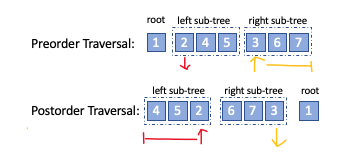Following the methods of Binary Traversal, it is also important that we are familiar with how to reconstruct a binary tree given its different form of traversal.
This post includes three different combinations of given traversals and the algorithms we used to build a unique binary tree.
Traversal Methods
First of all, it is vital that we are familiar with the traversal methods of a given binary tree.
Related explanations and code implementations can be found in my other post:
Combinations of traversals
- Preorder and Inorder Traversal : LeetCode 105
- Inorder and Postorder Traversal : LeetCode 106
- Preorder and Postorder Traversal : LeetCode 889
Note:
For the above methods, we assume that duplicates do not exist in the tree in the first place.
TreeNode Class:
class TreeNode(object):
def __init__(self, x):
self.val = x
self.left = None
self.right = NoneGeneral Method Description
Preorder traversal: Root - Left - Right
Inorder traversal:Left - Root - Right
Postorder traversal:Left - Right - Root

Preorder and Inorder Traversal
Description
- Use preorder to find the root value (first element)
- Locate the root value in inorder, dividing the left and right sub-trees from the inorder list.
- Recursion through the sub-tree to construct the whole tree
Code Implementations
def buildTree(preorder: List[int], inorder: List[int]) -> TreeNode:
def dfs(pre_left, pre_right):
# i and j and both closed interval
if pre_left > pre_right:
return None
# first element in preorder is the current root
root_val = preorder.pop(0)
root = TreeNode(root_val)
# locate the root in inorder
root_index = inorder.index(root_val)
root.left = dfs(pre_left, root_index - 1)
root.right = dfs(root_index + 1, pre_right)
return root
return dfs(0, len(inorder) - 1)Complexity:
Time complexity: O(n*2) due to list.index() function
Space complexity: O(n)
Time complexity Optimization with HashMap
Store the index of elements in the inorder list into a hashmap so that the search time would then be reduced to O(1)
def buildTree(preorder: List[int], inorder: List[int]) -> TreeNode:
def dfs(pre_left: int, pre_right: int):
# pre_left and pre_right and both closed interval
if pre_left > pre_right:
return None
# first element in preorder is the current root
pre_root = pre_left
# locate the root in inorder hashmap
root_index = index[preorder[pre_root]]
root = TreeNode(preorder[pre_root])
root.left = dfs(pre_left, root_index - 1)
root.right = dfs(root_index + 1, pre_right)
return root
n = len(preorder)
# build hashmap for inorder
index = {element: i for i, element in enumerate(inorder)}
return dfs(0, n - 1)Complexity:
Time complexity: O(n * 1) = O(n)
Space complexity: O(n)
Inorder and Postorder Traversal
Description
- Use postorder to find the root value (last element)
- Locate the root value in inorder, dividing the left and right sub-trees from the inorder list.
- Recursion through the sub-tree to construct the whole tree
Code Implementation
def buildTree(inorder: List[int], postorder: List[int]) -> TreeNode:
def dfs(i, j):
# i, j are both closed end boundary
if i > j:
return None
# the last value in postorder is the current root value
root_val = postorder.pop()
root = TreeNode(root_val)
# locate the root in inorder hashmap
root_index = index[postorder[root_val]]
# construct right subtree first
root.right = dfs(root_index + 1, j)
# then construct left subtree
root.left = dfs(i, root_index - 1)
return root
n = len(inorder)
index = {element: i for i, element in enumerate(postorder)}
return dfs(0, n - 1)Complexity:
Time complexity: O(n * 1) = O(n)
Space complexity: O(n)
Preorder and Postorder Traversal
Description

- Use preorder to find the root value (first element)
- The second element would be the left sub-tree root, use it in post order to get the length of left subtree
- Divide preorder and postorder, recursion through the sub-lists
Code Implementation
def constructFromPrePost(pre: List[int], post: List[int]) -> TreeNode:
if not pre:
return None
root = TreeNode(pre[0])
# reach leaf node
if len(pre) == 1:
return root
# length of left subtree
num_nodes = post.index(pre[1]) + 1
root.left = constructFromPrePost(pre[1:num_nodes + 1], post[:num_nodes])
root.right = constructFromPrePost(pre[num_nodes + 1:], post[num_nodes:-1])
return rootComplexity:
Time complexity: O(n*2)
Space complexity: O(n*2)
Optimization on Space Complexity
We use pointers instead of sub-arrays for recursion to save space.
Here (i0, i1, N) stands for pre[i0:i0+N], post[i1:i1+N].
def constructFromPrePost(self, pre, post):
def dfs(i0, i1, N):
if N == 0: return None
root = TreeNode(pre[i0])
if N == 1: return root
for L in xrange(N):
if post[i1 + L - 1] == pre[i0 + 1]:
break
root.left = dfs(i0 + 1, i1, L)
root.right = dfs(i0 + L + 1, i1 + L, N - 1 - L)
return root
return dfs(0, 0, len(pre))
Complexity:
Time complexity: O(n*2)
Space complexity: O(n)
Reference
- https://leetcode-cn.com/problems/construct-binary-tree-from-preorder-and-inorder-traversal/solution/cong-qian-xu-yu-zhong-xu-bian-li-xu-lie-gou-zao-9/
- https://leetcode-cn.com/problems/construct-binary-tree-from-preorder-and-postorder-traversal/solution/gen-ju-qian-xu-he-hou-xu-bian-li-gou-zao-er-cha-sh/